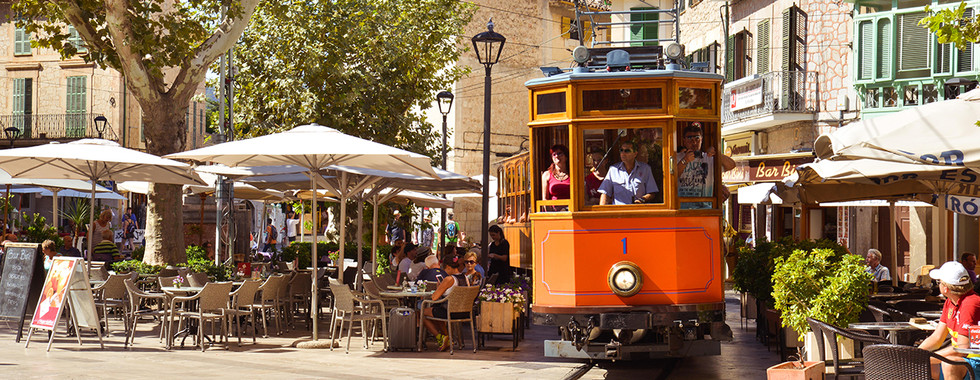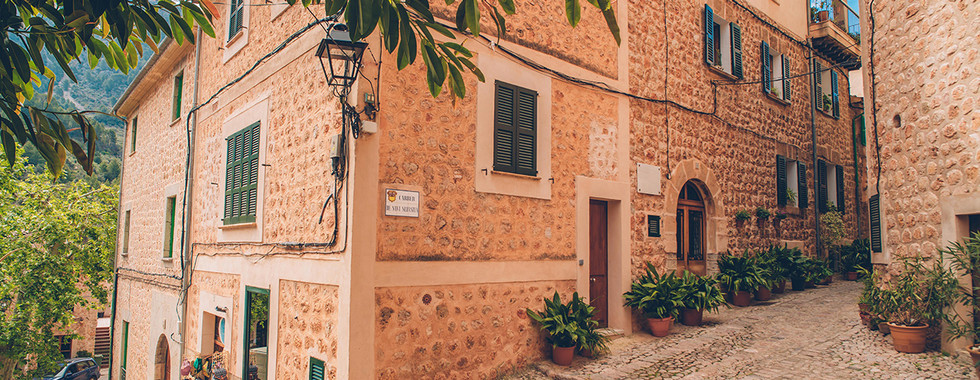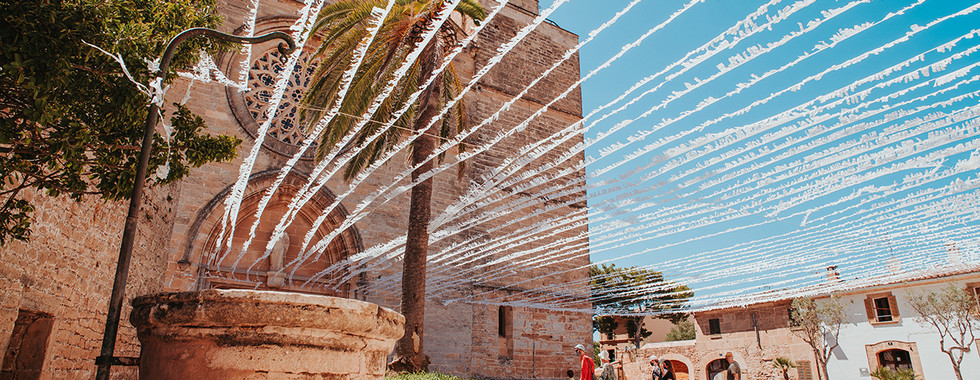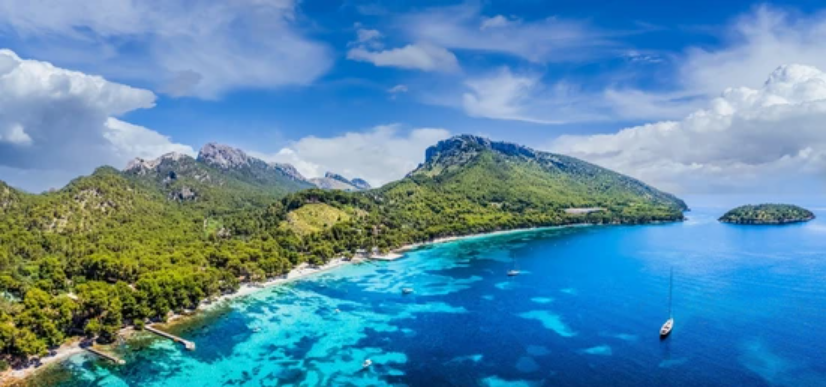Top Villages & Towns to visit for an Enchanting Holiday in Mallorca
- Biel Pitman
- Jul 2
- 11 min read
Mallorca might be famous for its stunning coasts, clear waters, and bustling nightlife. Yet, beyond the crowded resorts, there exists a collection of charming villages and towns worth getting away from the coast to truly enjoy the essence of the island. These spots scattered around the island provide a beautiful glimpse into Mallorca's rich culture, history, and breathtaking landscapes.
Here are some of our "must-visit" spots:
1. Sóller
Our neighboring town of Sóller sits in the heart of the scenic ‘valley of oranges’ or ‘valley of gold’ as it is sometimes known, it is also where we'll come back every summer for holidays, and what made us decide to move here. Our house is VERY near since it only takes about 18 minutes walking to reach it, and if you're staying with us, you'll probably end up spending some quality time here too, so you might as well get acquainted.The town of Sóller became wealthy because of the valley’s abundant citrus groves. In the 19th century, when the area was isolated from the rest of Mallorca by mountains, the oranges were shipped to France from the nearby west coast of Port de Sóller. Many locals went to work in France and returned to build some of the handsome Modernista properties that grace this town today (from which we're personally grateful).
The main square (Plaza de la Constitución) is Sóller’s beating heart, lined with numerous bars and cafés, and dominated by the distinctive valley landmark, Sant Bartomeu church. The tram linking town and port clunks its way regularly through this splendid square.
In Sóller, the sympathetically restored Art Nouveau building, Can Prunera, houses a fine permanent collection of art (including Kandinsky, Picasso, Warhol, local artists Miquel Barceló and Francesca Martí), and temporary exhibitions. The Balearic Museum of Natural Sciences (Museu Balear de Ciències Naturals) and the Jardí Botànic, a garden featuring many Balearic plant varieties, are a short walk from the centre, on the road towards the port.
The market in Sóller is on Saturdays, when shoppers and traders create a real buzz. The town isn’t really a notable shopping centre, but you'll be able to find everything you would expect from a truly traditional village, such as local products and crafts.
If you're a Hiker, you'll be in your element, with the Serra de Tramuntana’s GR221 long-distance path (the Dry Stone Route) passing through both towns. To walk with a guide, check out Mallorca Hiking or Tramuntana Tours (also bike rental). Keen cyclists can tackle the challenge of the Coll de Sóller (the tunnel is closed to cyclists), and mountain bikers have spectacular terrain to tackle.
Sóller has a thriving cultural scene, which includes events throughout the year. The celebration of its patron Saint Bartholomew sees the village come alive in late August in front of the church and in the town square. This five-day celebration includes exhibitions, concerts, as well as equestrian and sporting events. On the last day, the party always continues into the early hours of the morning with live music and lots of dancing.
Other events include the Moros i Cristianos and La Feria y el Firó in May, where the town celebrates an ancient battle it won in 1561. Visitors will enjoy seeing the town draped in flags while people in medieval costumes perform reconstructions of the famous conflict. A sweeter alternative is the Orange Festival, where Sóller showcases the very best of its orange harvest alongside music, food stalls, and much more. Besides visiting the Saturday Market (which is a must), we truly recommend two experiences to get the most out of your visit to the valley: To take the over 100 years old narrow gage train ride to Palma for one of the most fantastic and scenic daytrips (to and from palma, and remember to visit the Miro and Picasso Museum in Soller Train Station), and to also take the historic woden tram from Soller centre to Port de Soller if you're planning on enjoying a day by the beach.
2. Valldemossa
The highest town in Mallorca is probably best known as the place where the Polish composer Frédéric Chopin and his lover, the French writer George Sand, spent the winter of 1838/9, staying in rented rooms in the monastery. And, as a result, it’s probably Mallorca’s most visited town. You can visit Valldemossa’s Real Cartuja (Royal Carthusian Monastery), including the church, cloisters, and old pharmacy. Part of the monastery is King Sancho’s palace, which was later gifted to Carthusian monks, who converted it and other buildings into the monastery. It probably has more visitors than any other building in Mallorca, apart from Palma’s cathedral, La Seu. A ticket for the Real Cartuja includes a short Chopin piano recital. In line with its romantic atmosphere and quality sense of heritage, Valldemossa offers many opportunities for dining experiences ranging from the refined and romantic to the real and rustic. Es Taller (our favourite restaurant in the whole island and maybe the world) is the perfect place for a long leisurely lunch to rest the cobble-stone street walks that await in town, we're yet to find something in their menuy that isn't pure gastronomic perfection, and if you have any room left for dessert, don't forget to try "coca de patata" in any of the several cafes around town, is a local pastry adored by both locals and tourists. Virtually every café has its own version, and it often comes sprinkled with powdered sugar. Situated high above Valldemossa, Puig des Teix is one of the most visited peaks in the Tramuntana mountain range, this challenging route takes around four-and-a-half hours, and brings you right back to the bus stop, while for something less strenuous, simply stroll Valldemossa’s enigmatic cobbled streets lined with shops, boutiques, and plenty of places to eat and drink, pretty much every tourist’s shopping needs can be met somewhere in the town. But if you're interested in going directly to the producer, you can visit the agricultural estate of Son Moragues, which dates back 700 years (and where a good friend of ours has restored historic mills and produces amazing textiles with wool farmed on the estate and dyed with local herbs and plants). And while they offer tasting tours and activities, you can also visit their local shop in the town centre to see and sample some of their amazing produce, from their delicious organic jams to even gin or vodka,m but perhaps more importantly their olive oil which is the only 100% Mallorquin variety in the world.
3. Deià
Often referred to as the "jewel of the Tramuntana," Deià boasts an enchanting arts scene that has attracted writers and artists for decades. Its narrow streets are lined with traditional stone houses and provide spectacular views of the Mediterranean Sea. The steep valley in which Deià lies has been populated since prehistoric times, when early settlers lived in caves in the hillsides, hunted game, and drank from the plentiful natural springs. In the eighth century, Arab rule established a sophisticated drainage and irrigation system (still used today) and gave the village its name, stemming from ‘ad daia’, meaning hamlet.
After the crusades, three Roman-Catholic monasteries were constructed in and around Deià in the early 1200s: Ca l’Abat, Son Rul.lan, and Miramar. In 1867, a member of Austrian nobility, Archduke Lluis Salvador, arrived in Mallorca, with the intention of producing an encyclopedia on the Balearic islands. Finding astounding peace and beauty in the area of Deià and Valldemossa, he bought up much property and land here, banning tree felling and hunting within his grounds in an attempt at conservation, his stunning property (hanging on the cliff overlooking the mediterranean) was aqcuired few years ago by Michael Douglas, who tends to spend summers in the island.
English poet and novelist Robert Graves first moved to Deià in the 1930s, seeking respite after the nerve-shattering effects of the Great War, and finding love with American poet Laura Riding. A formidable literary pair, they left for England at the start of the Spanish Civil War; Robert returning after World War II, having a family home here until he died in 1985. Famous visitors who came to stay included Sir Alec Guinness, Peter Ustinov and Hollywood actress Ava Gardner. Robert Graves’ home, Can Alluny, is now an interesting museum.
Much of the Deià’s appeal lies in its laid-back vibe and blissful surroundings, visitors tend to opt for pleasurable eating and drinking experiences, with some enjoyable walks or hikes, and trips to Deià ’s small but very pretty cala. It’s worth taking time to stroll around, admiring the sympathetically restored old stone houses nestling in narrow alleys. Walk up to the church graveyard and you’ll find the simple headstone marking Robert Graves’ final resting place, appropriately set in the village he loved. The road through Deià is the main coast road and can be very busy, and parking in the village can be difficult during the summer when the small public car park is often full.
4. Fornalutx
If you're feeling like going for an uphill stroll from our house, at only 20 minutes walking north you'll find the beautiful town of Fornalutx. Often referred to as the ‘Prettiest village in Spain’, the stone buildings and red tiled roofs combine with the scent of the surrounding orange and lemon groves to provide a traditional rustic charm. Its history dates back over 1,000 years when it was originally an Arab farmstead. Its current unspoilt form started taking shape in the 13th century with the Catalan conquests. The Gothic church in Fornalutx was built in 1639. The population has steadily grown since then, but even with the influx of a more international community in more recent years, it remains in the hundreds. The effort to maintain the traditional look and feel, from the cobbled streets to the traditional façades, has created one of the best-preserved villages in Spain.
The village itself is undoubtedly the main attraction. Take your time to walk around the narrow streets admiring its architecture and traditional beauty, or make a pit-stop at the main square, which is surrounded by several good cafés. The building that stands out the most is the current town hall, which includes a 17th-century defense tower. The church is another must-see attraction, with the mixture of its original Gothic features and baroque renovations creating a unique blend. Fornalutx’s location in the Serra de Tramuntana makes it ideal for hikers and mountain bikers. It is within easy reach of the famous GR221 long-distance route that winds its way over the full length of the mountain range. If you're not an experienced hiker, we recommend you take a guide for this route, and Mallorca Hiking or Tramuntana Tours (also bike rental) can provide a capable and experienced guide should you need one.
5. Pollensa
Pollensa in the north of the island is an ancient town of attractive narrow streets and an impressive main square, lined with cafés, restaurants, and bars, and is just a few kilometres from Port de Pollensa (one of our favourite beaches to visit). Having been conquered time and time again through the centuries, the town bears signs of a rich history. The most ancient marks left on the local landscape are from the Talaiots, who arrived there more than 3,000 years ago. The best known ones were left by the Romans in 123 and can be found on the outskirts of the small town, which has around 16,000 inhabitants today. The old Roman bridge crosses the Torrent de Sant Jordi, which was built by the inventive Romans to provide the town with water. Peace reigned until 440 when the Vandals attacked, wreaking destruction and causing the surviving inhabitants to flee inland.
Pollensa’s formative history is eternally tied to the legendary order of the Knights Templar, though the town’s foundations were laid by the Arabs, who constructed irrigation systems, enabling agriculture to flourish. They were ousted in 1229 by King Jaime I, supported by hundreds of knights. Previously, the order had been assigned the role of protecting and mentoring the orphan boy king, until he was ready to lead and had learned the art of kingship, who, following the successful invasion, divided the island up, and gave Pollensa to the knights who helped him conquer it.
After the Templars, the Jesuits arrived, constructing Pollensa’s Church of Monti Sion in 1697, but not before a turbulent period in the 15th and 16th centuries. Pirate raids were a regular event in this part of Mallorca, and the most famous was the Moorish invasion in 1550. Local man Joan Mas led a small band of fellow citizens into battle against the invaders and despite being armed with only sticks, they defeated the enemy. The event is commemorated every August 2nd in a noisy battle re-enactment (much like they do in Soller in May), with townsfolk dressed as either Christians or Moors, as part of Pollensa’s Mare de Déu dels Àngels fiesta. More recently, in the early part of the last century, a colony of artists, writers, and musicians discovered the inspiring beauty of the area, settling in, and Pollensa has been a major draw for tasteful visitors ever since.
6. Alcúdia
The vibrant northern town of Alcúdia is truly a year-round location, offering life, history, and culture throughout all seasons. Lying just one kilometre inland from the famous holiday resort town of Port d’Alcúdia (Much like Port de Soller), it’s the ideal place to taste rich Mallorcan heritage, without having to stray too far off the beaten path.
Dramatic past events have left their mark everywhere in Alcúdia. First inhabited by the Phoenicians and Greeks, then established in 123 B.C. as the Roman settlement Pollentia, it was subsequently attacked by Vandals, Byzantines, and Arabs, before finally being conquered by Catalan Christians. The conquerors left their cultural heritage behind, which is still visible today in the town’s small alleyways.
The historic centre of Alcúdia is enclosed by Mallorca’s only entirely preserved town wall, erected in the 14th century by King Jaume II to protect Alcúdia’s inhabitants. It wasn’t, however, enough to keep out the marauding pirates who attacked the city again and again in the 16th century, causing many of the population to flee. Today, it’s hard to believe that this bustling town was once at risk of being deserted completely. Thankfully, in 1779, the construction of a harbour saved Alcúdia from decline.
The pedestrian area offers inviting restaurants, cafés with beautiful terraces and cosy backyards, handicraft shops, stylish boutiques and Mallorcan specialities. Stroll by medieval houses, the proud town hall, and the so-called Casas Señoriales, the majestic houses of past nobility. Here and there, you get a glimpse of one of the big, shady patios, and time and again, you reach the outer rim of the town wall.
This ancient enclosure is also the protagonist for a unique experience, which never fails to cast its spell over inhabitants and visitors alike. During the summer months, the town wall is the romantic setting for open-air concerts and theatre functions. While the music ranges from medieval music to cool Jazz, the plays are dedicated to Alcúdia’s history. Dressed in costumes of the respective era, the actors breathe new life into historic personalities and take the spectators back in time. There is no entrance fee, and programmes can be obtained in the tourist information office.
Don’t miss Alcúdia’s famous open-air market. Held every Tuesday and Sunday, there are two sections: one for the island’s farmers selling locally-produced produce, and another dedicated to everything from shoes, handbags, and jewellery, to clothing and souvenirs.
The smallest Roman amphitheatre in Spain is situated right here in Alcúdia. A kilometre or so to the south of the town, towards the harbour, it forms part of the ancient Roman city of Pollentia. Also home to a forum and the houses of La Portella, the site was used as a necropolis in late Roman times, and the evocative remains of tombs can be seen amongst the theatre stands.
Pollentia was a perfectly planned city, complete with a Capitoline temple and numerous taverns. If you are into history, you’ll find the archeological excavation sites at this spot fascinating. Maps are available at the tourist information office in the pedestrian area.
7. Artà
The traditional town of Artá sits in the middle of a large valley at the foot of a small mountain in the northeast of Mallorca. The town rigorously clings to its heritage, making few concessions for tourism. The parish church, Transfiguracio del Senyor, dominates the largely pedestrianised centre and skyline of Artá.
Artá is overlooked by the fortified Santuari de Sant Salvador, which is a major attraction for visitors to the corner of the island. It takes a very pleasant long stroll up the tree-lined walkway, which, with 180 steps, can be a challenge in itself. The sanctuary and its walls were originally constructed in the 14th century, but were rebuilt in the 19th century. The church features some fabulous artwork, and the sanctuary’s courtyard provides the perfect place to sit and soak up the views.
Perhaps a lesser-known fact about Artá is that it was one of the last places in Europe to suffer an outbreak of the bubonic plague. The nearby beautiful fishing village of Colonia de Sant Pere was established by survivors who moved out of Artá to avoid becoming infected.
Historically, the area around Artá is well-known for its production of pottery and for basket weaving. Archaeological digs have unearthed woven fibers that suggest these traditional skills are amongst the oldest crafts on the island.
Artá’s biggest attractions relate to the cultural heritage of the area. The most popular is undoubtedly the Sanctuary de Sant Salvador and the fortified battlements that surround it.
In addition to these, the nearby talaiotic town of Ses Paisses, the Sa Canova talaiot, and the baroque-style Franciscan convent of Sant Antoni de Pádua all provide additional doses of history and culture.





























































































































































































































Comments